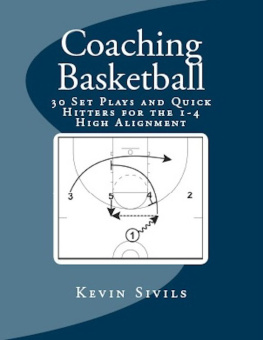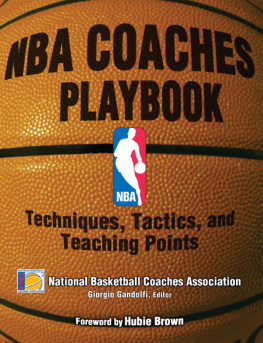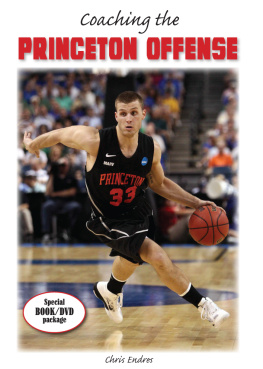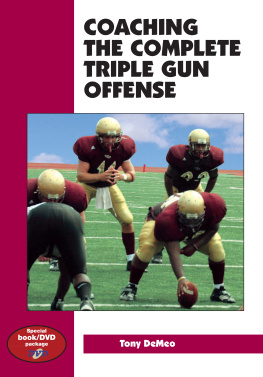While every precaution has been taken in the preparation of this book, the publisher assumes no responsibility for errors or omissions, or for damages resulting from the use of the information contained herein.
EFFECTIVE MAN TO MAN OFFENSES FOR THE HIGH SCHOOL COACH
First edition. July 31, 2013.
Copyright 2013 Steve Biddison.
ISBN: 978-1489524164
Written by Steve Biddison.
10 9 8 7 6 5 4 3 2 1
About Coach Biddison
C oach Steve Biddison has coachedbasketball for over 20 years where he has not only become known as a veryinnovative defensive coach, but a coach whose teams execute the half courtoffensive game to perfection. Four times he has taken over programs that hadnot had a winning record in years and each time turned them into a playoff teamin his first year with the program. Most notable was the year he took over aprogram that had only won two games the previous year and four games over theprevious three combined years. By instilling a new philosophy centered aroundthe HEART (Coach Biddison details this philosophy in his popular book CoachingFrom the HEART, which is also available in both ebook and paperback form)and a new style of offense and defense, Coach Biddison took that team threerounds in the playoffs in his very first year in the program.
Along the way in his coachingjourney, Coach Biddison has achieved:
A 426-161 Coaching Record
Named South Texas BasketballCoach of the Year in 2005
5 Times District Coach of the Year 1991,1995,1996,2004.2005
State Ranked 5 years (ranked 4thin the final State polls in 2004)
Regional Finals twice - 1996,2004
Regional Semifinals twice 1995,1997
Regional Quarter finals (AreaChampions) twice 1998, 2005
Area Finals once - 2010
#1 Defensive team twice (based onpoints allowed) 1996, 2005
# 1 scoring team in the state (96points per game) once - 1992
65% Playoff winning percentage
Man-to-Man Offenses
B asic Concepts
One of the hardest things fordefenses to defend is a good screening offense. Therefore, man-to-man offensesshould primarily be a screening offense designed to get shots at or near thebasket.
A team that become a good screeningand moving team will begin to see defenses start to switch the screens insteadof trying to fight through or over the screens. This is when well coachedoffenses begin to exploit defenses by looking to screen a guard for a big or abig for a guard. If they switch those screens, it will cause a mismatch,enabling the offense to get to the basket easier.
One of the most important concepts ofany man-to-man offense is timing and execution. If your timing on one side ofthe floor is not in sync with the other side of the floor, your player may comeoff a screen wide open, but no one is there to give them the ball. Therefore,you must practice the timing of the plays until it is automatic. There is noshort cut for practice when it comes to execution of the offenses.
Initial Look
Obviously, the wide open layup on afast break is the first best option 90% of the time (the only exception is whenyou are trying to hold the ball at the end of the game). Therefore, you shouldlook to push the ball early in a fast break situation in order to get as manyeasy layups as you can.
In order to do this, it is importantthat all positions do their job on the break and fill their lanes. Dependingon your philosophy of a fast break, you may choose to fill lanes on the fly andhave each player decide at the moment of a rebound, what lanes they shouldfill. I personally though subscribe to the numbered fast break idea where eachposition on the floor has a responsibility on to fill certain lanes on bothfast breaks and made basket opportunities. For instance, my two guard willalways fill the left wing on the break because coming from the left side of thebreak puts him in position to execute our secondary break which then flows rightinto our any one of our offenses. Its not that it cant be done with the twoguard running the right wing. It is only a matter of making a very simplealteration to the secondary break to still allow for easy entry into one of theoffenses.
NumberingSystem
For the sake of the diagrams in thisplaybook, the following numbers will be used for the following positions on thefloor.
1 Point Guard your best ballhandler and distributor.
2 Shooting Guard (right wing) Usually your best shooting wing player. He can be interchanged with 3.
3 Small Forward (left wing) Usually your best rebounding wing player. He can be interchanged with 2.
4 - Power Forward (one of the twopost players, usually the smaller of the two). He can be interchanged with 5.
5 - Center (usually the bigger ofthe two post players). He can be interchanged with 4.
L ets take a look at how the fastbreak can be run in a way that flows right into a secondary break that sets theplayers up to run one of many different half court offenses.
The Fast Break
E veryone must first do their jobin securing the defensive rebound. If you do not secure the rebound, thenthere can be no fast break. I would suggest you strongly emphasize defensiverebounding, not just when practicing defense, but also when practicingtransitioning into offense.
Diagram1.1

A s soon as the rebound issecured:
1 sprints up the court to thelane line extended on the ball side. It is essential that he makes himselfavailable to receive the outlet pass.
The person who rebounded makes agood outlet pass to 1.
2 and 3 sprint down the court intheir lanes. The first three steps are critical in beating the defense. Drillthis into your players minds. The success of failure of a fast break happensin the first three steps. Teach them to push hard for those three steps togain the advantage down the court.
4 runs straight to the rim.
1 will take only as many dribblesas needed before passing up the floor to the breaking wing. Lead them withthe pass to the basket.
If no wing gets the ball, theywill cross to the opposite baseline in order to flow straight into thesecondary break. If you choose to run your wings opposite this diagram, youmight choose to keep your wings on the same side instead of crossing. In thiscase, they will simply back out towards the baseline three point shot on theirside of the court.
The Secondary Break
I fwe do not get an open layup on the initial push of the ball, we go immediatelyinto our secondary break, which is designed to still get a layup. You couldlook at the secondary break as being the second wave of a fast break. Butagain, it is important that everyone does their job.
InDiagram 2.1 below, the initial fast break did not produce a lay-up and 2 and 3have already crossed to the other side of the lane.
Secondary Break Option 1
Diagram 2.1

A fter 2 and 3 cross, 1 picksa side to dribble to and hits that wing on the baseline.
If your timing is perfect, 2may have a quick touch pass to 4 who has sprinted to the front of the rim (seeinitial fast break where 4 sprints to the front of the rim.














